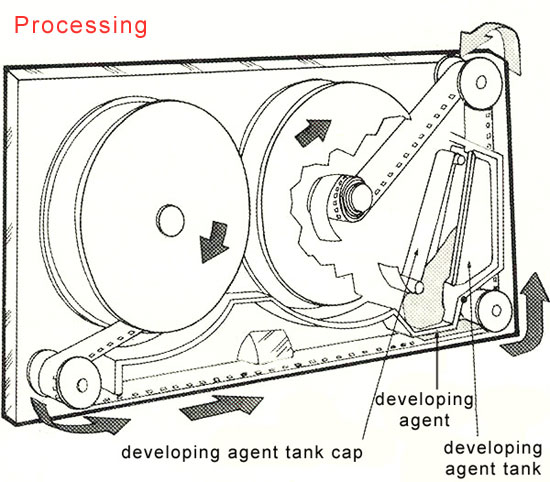|
||
|
Film never leaves cassette, for exposure, processing, projection or storage. During exposure (with cassette vertical into Polaroid Polavision Land Camera), film moves supply reel over pressure plate onto take-up reel. It's moved by camera claw, which enters perforations near aperture. For processing, insertion of cassette into Polaroid Polavision Player, aperture side down, automatically rewinds film onto supply reel. Start of rewind causes a pull tab in cassette to open a pod seal in reagent chamber. Reagent (only 12 drops are needed) flows by gravity to a tiny nozzle above the film. Film, passing at high speed, is coated in 20 seconds. A coater bar spreads reagent evenly in a 6.5-micron layer. With film wound up tight on supply reel, tension of film throws a switch that stops everything (an causes system to pause for 45 seconds to allow chemicals to complete reaction). Then projection begins, with light directed from side through plastic prism. All Polavision phototape cassettes have the following characteristics in common: film width (8 mm), film length (38.5 feet), frame size (4.2 x 5.7 mm), perforation (8-mm Type S), frames per cassette (2800 frames) and packaged in sealed cassette. Weight: 85 gr. Dimensions: 15 x 70 x 130 mm.
Polavision movie film is an additive color film, as the Dufaycolor, Autochrome Lumière or Finlay Colour. The illusion of color is formed by adding together proper proportions of red, green, and blue light. The film surface is made up of strips of alternating red, green, and blue filters. On the film base, they are imprinted microscopic stripes of color in triplets (4500 per inch). These filters act both during exposure and during viewing to reproduce color. Polavision film in essentially black-and-white film that has been adapted for color by this clever mechanism. |
||









